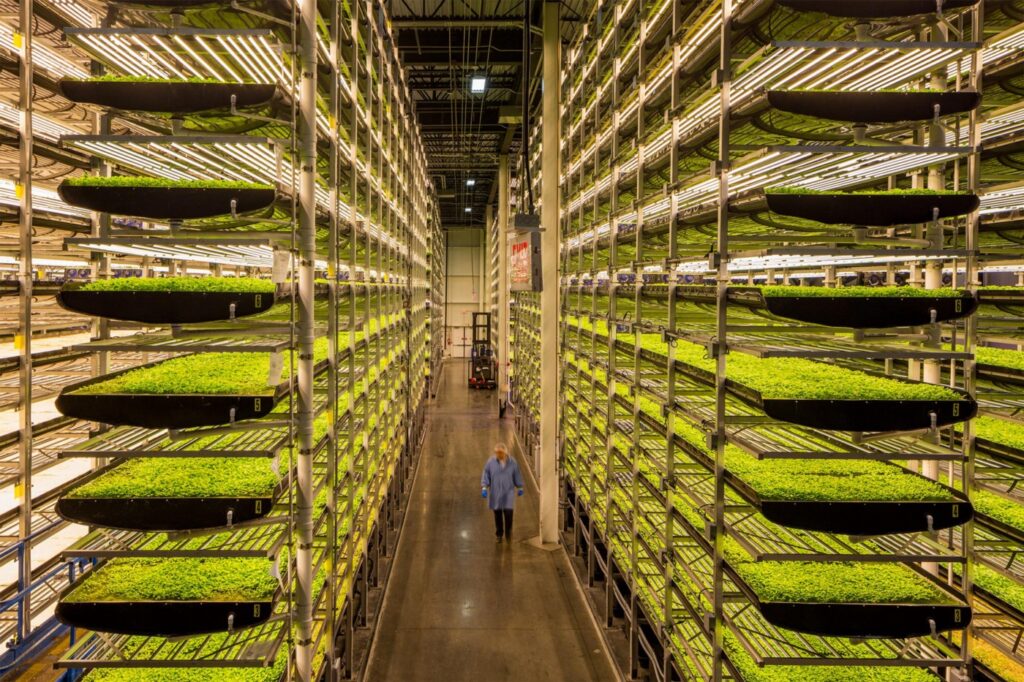
The global vertical farming market is actively developing and growing. It is believed that this relatively new type of farming is changing the agriculture sector and can help solve environmental problems. Let’s find out whether it’s true.
What is vertical farming?
Take a spacious building, hundreds of high shelves or pillars, no sunlight and rain, only artificial lightning and various technologies (dosing systems, the Internet of Things, sensors, AI, ML, and many others); there we go: we can start growing products vertically indoors. Of course, it is more complicated, but hopefully, the main idea is clear.
What food can be grown?
Most indoor farms grow herbs, salad leaves, and strawberries. Technically, it is possible to cultivate anything on such farms, but the problem is profitability. To grow wheat, potato, or rice, we need much more time and light than to grow, for example, lettuce. More time and energy mean more costs and a higher price for the final product.
According to Science Focus, a loaf of bread made from indoor-farm wheat will cost around $18. For comparison, a usual loaf is a dollar, give or take. So, it doesn’t make sense to produce crops with a long growing season on indoor farms.
What are the advantages?
Vertical farms are good for the environment.
For example, such farms use less water than usual farms. Nordic Harvest, Europe’s largest vertical farm, says: “We use up to 250 times less water compared to conventional agriculture.” Another company, the Jones Food Company (JFCo), says that they clean and reuse water up to 30 times, which significantly reduces its waste.
Also, the plants are located indoors, so pesticides used to protect crops from pests and disease carriers are not needed. Not using pesticides means not releasing them into the environment and accordingly not polluting it.
Vertical farms can be easily located in the cities, near the consumers. So, there is no need to transfer products over long distances, which means less fuel is used and crops stay fresher.
Growing crops vertically saves space that can be used for something beneficial, for example, planting more trees.
Moreover, crops cultivated in a controlled environment are more consistent in appearance and flavor. Many products are wasted because they do not look appealing enough to consumers. That is why consistently having good-looking crops helps reduce food waste.
Finally, indoor farm products do not depend on weather conditions and climate thanks to technologies that create a sufficient growing environment. Hence, crops can be grown throughout the whole year.
What about disadvantages?
With all the advantages, it can sound as if vertical farms are a salvation, the perfect solution to countless problems, and should be used more actively. But unfortunately, it’s not that simple, and there are some pitfalls.
First, indoor farms require a lot of energy to power various equipment. Energy costs a lot, while rain and sunlight used for conventional farms are free. Some farms use fossil fuels to produce electricity, contributing to environmental problems and not solving them. But other companies decided to rely on reusable energy.
For example, according to the Guardian, the Jones Food Company will cover their farm roofs with solar panels and use neighboring land for future solar panels or wind turbines. However, whether this will be enough to power the whole farm is a question.
Then, setting up and maintaining many technologies used on a farm is very expensive. Apart from these costs, we need to consider the costs for buying real estate. The buildings used for vertical farms are huge, hence expensive. And it is important to repeat that not all crops can be grown on vertical farms and be cost-effective.
Final thoughts
According to Grand View Research, in 2019, the global vertical farming market was valued at $1.02 billion. Fortune Business Insights claims that this number turned into $4.16 billion in 2022 and predicts that it will reach $20.91 billion by 2029. So, it does look like indoor farming has a lot of potential.
Considering that vertical farms can help solve environmental problems, faith in them increases. However, finding ways to decrease the costs for setting-up indoor farms and maintaining them is vital for vertical farming to be as beneficial as possible.
It doesn’t look like we will be buying potatoes, wheat, or other staple crops produced on indoor farms, but buying herbs, salad, strawberries, and some other products from such farms is already a reality.
Resources:
https://www.sciencefocus.com/science/what-is-vertical-farming/
https://www.grandviewresearch.com/industry-analysis/vertical-farming-produce-market
https://www.wired.com/story/wired-impact-infarm-vertical-farming/
https://www.fortunebusinessinsights.com/industry-reports/vertical-farming-market-101958
